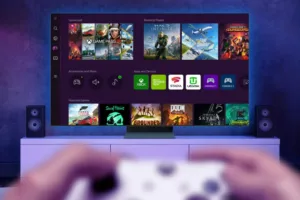Overall total consumer spending on video games in the United States totaled $56.6 billion in 2022, down 5%, according to the Entertainment Software Association and the NPD Group.
GamesBeat
The groups said that video game sales stabilized following back-to-back record years in 2020 and 2021. The $56.6 billion figure includes revenues from all content categories (including full-game, post-launch and subscription spending across console, cloud, mobile, portable, PC and VR platforms), hardware and accessories.
The bank reminds clients that 2022 proved to be a “corrective year” for the games sector, where the industry overall suffered a 10 per cent underperform (when compared to the global index), and that 2023 should be better. But there are favourites in a very long list of runners and riders.
Advanced Television
Computer gaming is going through a transitionary period, one which may not jibe with everyone’s opinion of what computer gaming should be or is. Whether you believe cloud and streaming gaming are the future, or merely a niche opportunity, there’s some play in the smart TV market. Samsung probably has the most visibility with its Gaming Hub. I guess if your TV is going to be smart it needs to be smart enough to let you play games on it, too. However, smart TVs are not going to replace consoles and PCs. We have to look at the smartphone market as being a potential driver of streaming games on your smart TV. If you treat the TV as an in-home social hub, and you can have a seamless experience playing games on streaming services on TVs and mobile phones, just like your other streaming entertainment, then the market opportunity goes beyond our line of sight view of today’s gaming demographics.
If there are billions of smart phone users then gamers with PCs and consoles are a fractional crossover audience, a very lucrative fraction, thereof. Add the total cost of ownership for devices: smart phones, smart TVs, consoles, computers, and you get a limiting factor for growth: too many very expensive, smart devices to choose from, and too many formats for the games being delivered, with very little consistency in terms of quality or performance unless the user is a high-end consumer PC user or a console player.
These issues then to be socio-economic which translates into the best games and gameplay being accessible by only a small portion (people with the means) of the total accessible market (nearly everyone). Granted there are issues with latency and bandwidth for streaming games, but those problems will be mitigated by continuous development of infrastructure by telcos and cable companies. You can, given the right circumstances, enjoy 4K PC gaming on your TV.
And, if you are still skeptical, you can try and trawl through YouTube and watch a lot of commentary of GeForce Now, most of it coming from regions that would love streaming gaming because of the prohibitive cost or lack of access to hardware platforms. Everyone can get a decent enough connected TV setup. Everyone should be getting games on their TVs. That’s the mantra.

